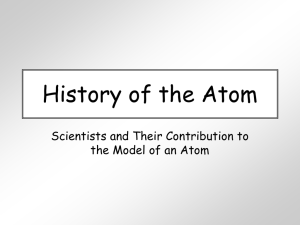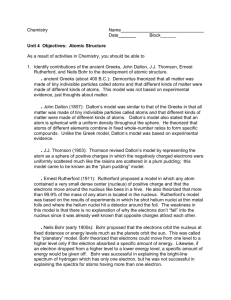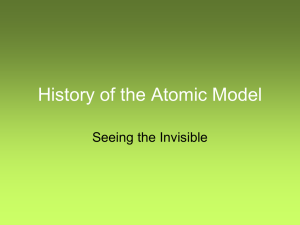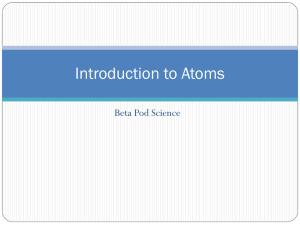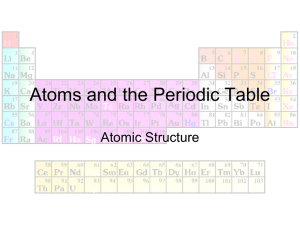Atomic Structure & Its History
advertisement
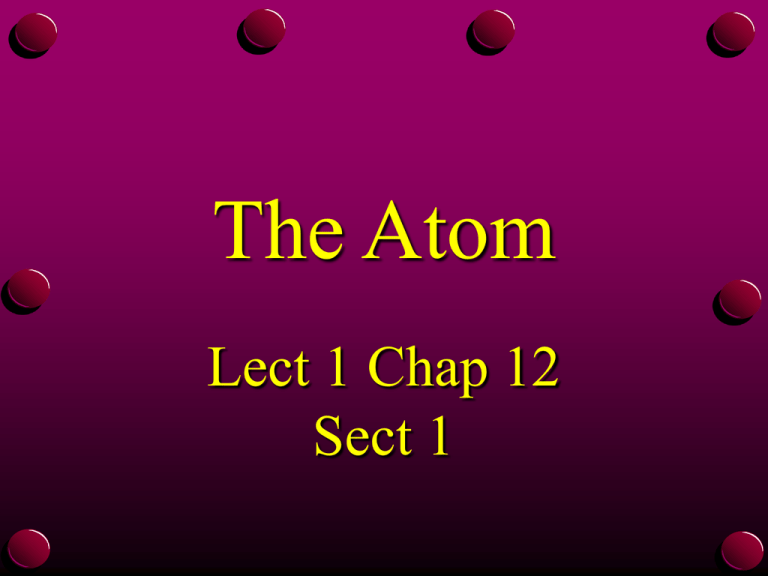
The Atom Lect 1 Chap 12 Sect 1 Obsertainers: How do you determine how something is designed, if you can’t see in it? Lab: Obsertainers: take one Draw 3 circles and label: Hypothesis, retest, actual Complete: you have 3 minutes Atomic Structure & Its History • Much of what we know about atomic structure today is the result of indirect observation of atoms and the particles of which they are composed. Atomic Structure & Its History • • The Greek philosopher Democritus was the first to propose that matter was composed of atoms, and that was over 2,300 years ago. Atomic Structure & Its History • He believed that atoms were those parts of nature that could not be cut down any further. Atomic Structure & Its History • • He was correct in one part: the forces that hold together the nucleus of an atom are the most powerful in the entire universe making atoms indivisible in all but extremely powerful reactions. Atomic Structure & Its History • • • Those reactions are called fission, and it is when the nucleus of an atom is split apart. When this occurs tremendous energy is released. Atomic Structure & Its History • • • Nuclear weapons are an example of this incredible force. Direct observation of atomic structure is all but impossible. Scientists have relied on models to represent the structure of atoms. The Dalton Model: 1803 • • • English chemist John Dalton developed the first model in 1803. He saw them as indestructible, indivisible and spherical. The Dalton Model: 1803 • His theories were based on what had been observed in chemical reactions and was widely accepted until the development of the Crooks tube The Crooks Tube • • • The Crooks tube is the ancestor to television tubes. English scientist JJ Thompson noticed that a stream of negatively charged particles would flow through the tube no matter what gas was used. He theorized that negatively charged particles were present in the atoms of all elements. The Crooks Tube • His final theory was that atoms were made up of positively and negatively charged particles evenly distributed and that the atoms was a solid mass. The Crooks Tube 1. Crooks Tube Shown & Explained QuickTime™ and a decompressor are needed to see this picture. The Rutherford Model: 1909 • • British physicist Lord Rutherford’s experiments in 1909 indicated that atoms were largely empty space. The Rutherford Model: 1909 The Rutherford Model: 1909 2. The Rutherford Model QuickTime™ and a decompressor are needed to see this picture. The Bohr Model • • Danish scientist Neils Bohr developed a model of the atoms that proposed certain definite orbits in which electrons traveled. Bohr proposed 7 different levels, or distances that occur around the nucleus. The Bohr Model • The greater the radius of the level, the greater the energy of the electrons at that level. The Bohr Model • • His models suggested that in an atom’s normal state, all electrons are in the lowest energy levels, and because of this cannot move to a lower level. The atom is stable and said to be at its ground level state. 3. The Bohr Model Put notes at the bottom of the page- 3 bullet points QuickTime™ and a decompressor are needed to see this picture. The Excited State • • • If energy is added to the atom by heat or electrical energy, the absorbed energy can cause one or more of the electrons within the atom to move to a higher energy level. When this happens the atoms are said to be in an excited state. The Excited State • • • The atom at the excited state is unstable and makes efforts to return to ground level state. As the electrons return to this level they release energy. The energy given off exactly equals the amount absorbed when the electrons moved to the higher energy levels. The Modern Model of the Atom This is the drawing for your Little Bk Cover. Be sure to label Charge Cloud Model: • this shows electrons as being part of a diffused cloud of varying densities . • (Be sure to include labeling of electrons in the electron cloud and protons & neutrons in the nucleus) Brainpops: Atomic Models Brainpops Brainpop quiz How did you do? 4. A Musical Review QuickTime™ and a decompressor are needed to see this picture.

